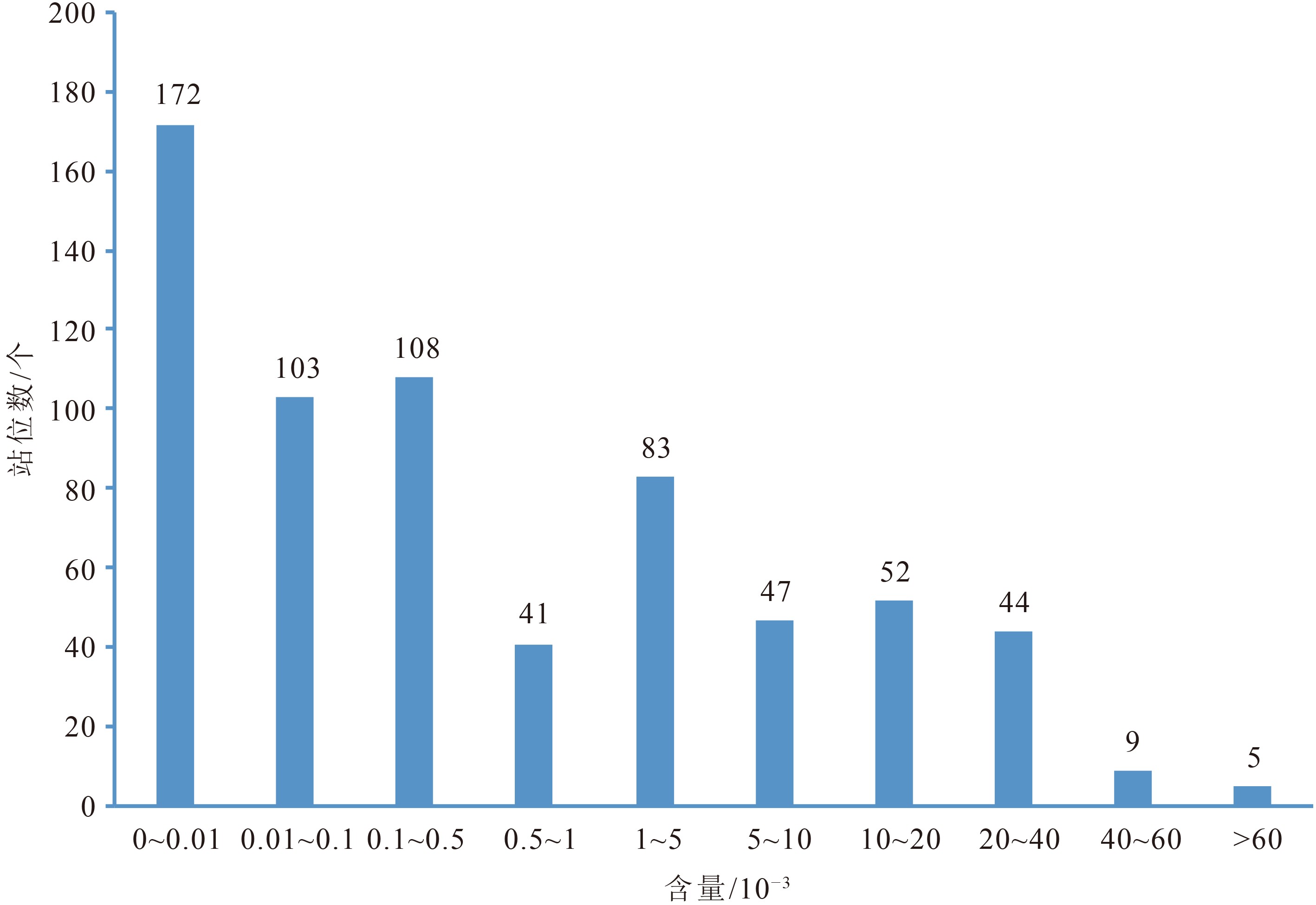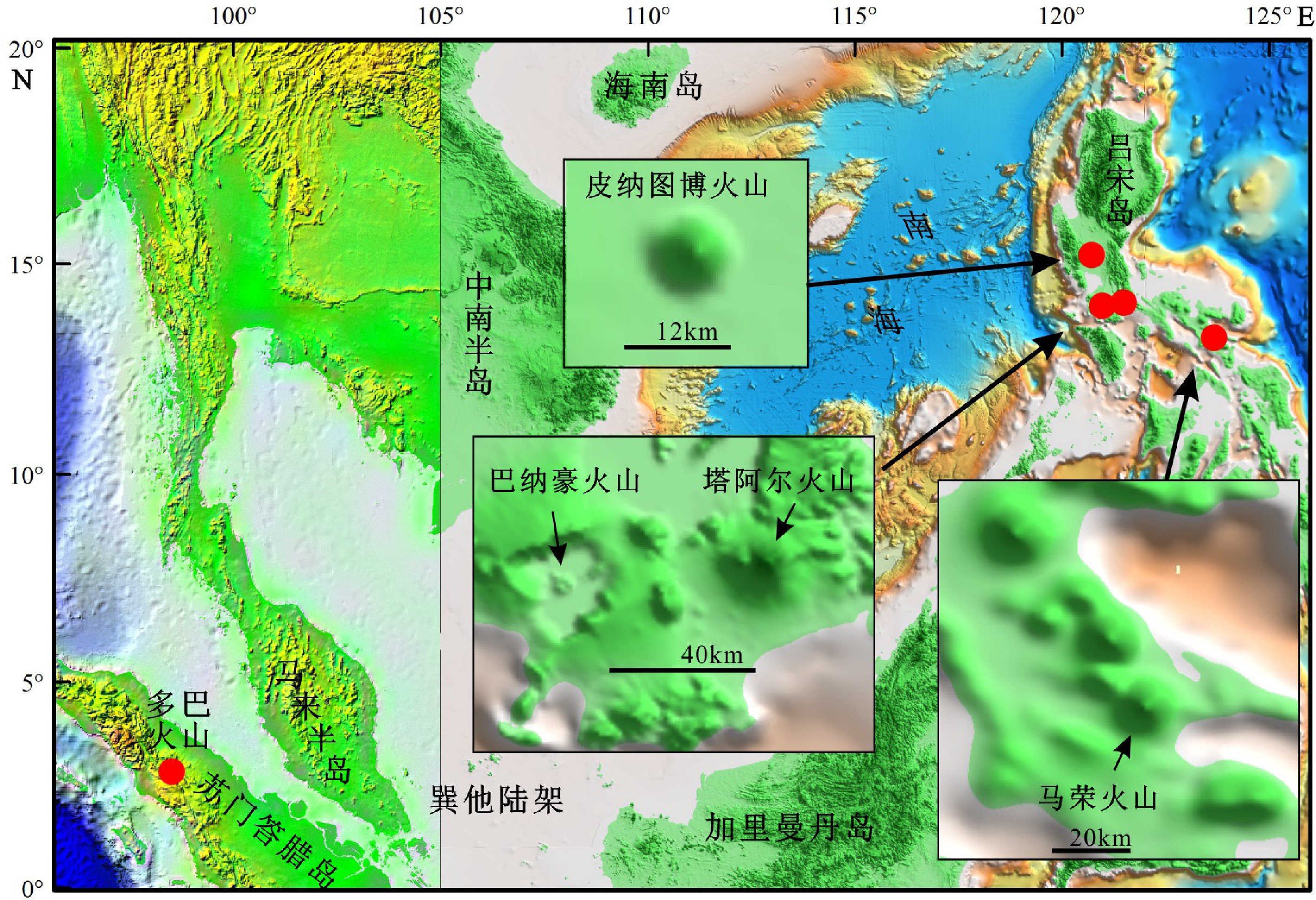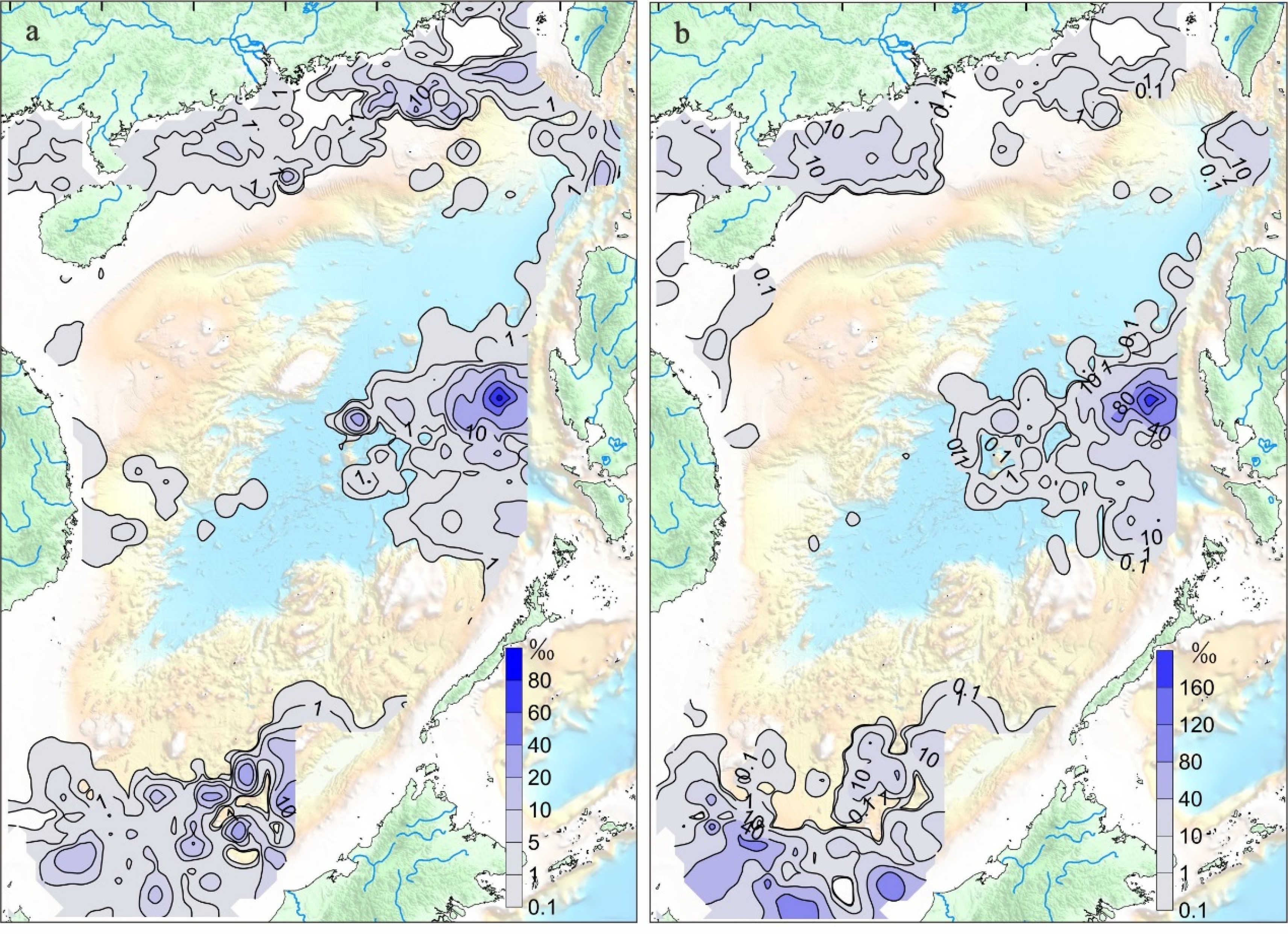Distribution pattern of volcanic glasses in the surficial sediments of the South China Sea and their provenance
-
摘要: 火山碎屑是边缘海沉积的重要来源,其分布特征对研究沉积作用与构造活动具有重要意义。对南海2276个表层站位碎屑矿物分析表明,664个站位含火山玻璃,占总站位数的29.17%,其中含量最高达95.8×10−3。表层沉积物火山玻璃主要出现在南海东部海域,往西呈逐渐降低趋势。南海东部主要重矿物磁铁矿和角闪石分布与火山玻璃十分相似,表明可能具有相同的来源。这些特征表明火山玻璃主要来自菲律宾群岛。这与南海东缘的琉球-台湾-菲律宾火山-地震带的吕宋岛大量活火山分布吻合。南海南缘苏门答腊-爪哇岛弧火山-地震带,虽然第四纪火山和地震活动频发,但对表层样火山玻璃贡献不大。南海海域火山可能有少量贡献,但不是主要因素,南海北缘及西缘基本没有贡献火山玻璃。Abstract: Pyroclast is a kind of important sediment source to marginal seas and the distribution of it is of great significance to the study of sedimentation and tectonic activities. In this paper, the detrital components from 2276 surficial samples of the South China Sea are studied. Volcanic glasses are found in 664 sites, accounting for 29.17%, of which the maximum is as high as 95.8×10−3. The volcanic glasses mainly occur in the eastern part of the South China Sea and gradually decrease westward. The distribution pattern of the main heavy minerals, such as magnetite and hornblende, is similar to that of volcanic glasses, indicating that they may have the same origin. Data suggests that volcanic glasses are mainly sourced from the Philippine islands. It is consistent with the distribution pattern of active volcanoes widely distributed in the Luzon island and partial Ryukyu-Taiwan-Philippines volcanic arc and seismic zone along the eastern margin of the South China Sea. The Sumatra-Java volcanic arc and seismic zone in the southern margin of the South China Sea, although there are frequent Quaternary volcanic and seismic activities, does not contribute much volcanic glasses to the surficial sediments. Volcanoes in the South China Sea are not the main contributor and the northern and western parts of the South China Sea have almost contributed nothing.
-
Keywords:
- volcanic glass /
- surficial sediment /
- provenance analysis /
- South China Sea
-
火山碎屑是南海沉积的主要来源之一,其含量、分布和源区特征对研究南海的沉积作用与构造活动具有重要意义[1-5]。前人对南海部分海域火山玻璃的含量、分布及其成分特征作了一些研究,初步探讨了火山物质的来源与搬运过程、火山喷发的关系[2,5-10],并对局部海域火山玻璃的分布特征进行了较详细的研究[11-13]。杨群慧等对南海东部表层沉积物中火山玻璃研究认为[14],其主要来源于附近弧状列岛的火山喷发物,基性火山碎屑矿物则主要来自海底火山岩的剥蚀物。陈忠等认为菲律宾岛弧火山带、南海深海盆火山喷发以及印尼岛弧火山带是南海火山玻璃的主要源区,火山玻璃的搬运和沉积主要受台风、越赤道气流和环流的影响与控制[4]。此外,利用柱状样研究晚更新世以来火山玻璃组成与分布特征,探讨其来源[2,15];也开展了南海周边源区,包括东部菲律宾群岛[16],北部华南地区等火山喷发特征及其物质组成,为海域火山物质来源提供参考。总体来看,受取样的限制,对南海海域火山玻璃分布特征的研究明显不足,缺乏整体的认识。
笔者近年对南海全海域进行系统取样,进行火山玻璃的分析鉴定与统计,旨在认识南海沉积物中火山玻璃分布的整体特征及其来源。
1. 材料与方法
1.1 表层沉积物样品
南海表层沉积物取自南海全海域,包括陆架、陆坡和深海盆地,总共2276个站位(图1)。取样方式包括抓斗取样、箱式取样和柱状取样。对箱式样和柱状样,通常取0~10 cm代表表层样。
1.2 样品处理与鉴定方法
按统一标准对表层样品进行碎屑矿物鉴定,大部分样品由广州海洋地质调查局测试所分析测试,部分由海南省地质测试研究中心完成。
海洋沉积物碎屑矿物鉴定,依据《海洋调查规范 第八部分:海洋地质地球物理调查》GB/T12763-2007,具体步骤按以下技术要求进行:
(1)将样品自然风干或烘干后,采用1/100的天平称取定量干样,通常为5.00 g;
(2)将样品置于烧杯中,加水充分浸泡后,冲洗,过筛,选取粒径0.063~0.25 mm的样品;
(3)将样品自然风干后,采用1/1000天平称其质量;
(4)淘洗,分离出相对重、轻矿物两部分;对重矿物部分进行磁选、电磁选;采用1/1000天平称分选后各部分质量;
(5)在实体显微镜下鉴定各类碎屑矿物,其中包括火山玻璃,并目估其含量,最后统计火山玻璃含量。
由于研究区范围很大,涉及沉积物类型很多,碎屑矿物含量变化很大,在碎屑矿物含量很低时,颗粒相对含量可能失真,因此换算成干样含量,可以更好地反映其区域分布特征。
2. 表层沉积物火山玻璃分布特征
南海表层沉积物样品火山玻璃呈橙黄色、浅褐色、灰白色等,透明至半透明,性脆,主要呈不规则的多角状、平板状等。火山玻璃是岩浆喷出地表时,因突然冷却、来不及结晶而凝固形成。因岩浆中含有大量气体,南海火山玻璃的气孔、气泡特别发育。根据火山玻璃主要成分分析,南海棕色火山玻璃为安山岩玻璃,白色火山玻璃为流纹岩玻璃[3]。
对2276个表层站位进行碎屑矿物鉴定,其中664个站位含火山玻璃,占总站位数的29.17%,其中424站位含量<1×10−3,130个站位含量为1×10−3~10×10−3,110个站位含量>10×10−3,最高含量为95.8×10−3,各区间站位数见图2。
南海火山玻璃主要分布于中东部深海海域,含量在20×10−3以上高值区主要分布于菲律宾群岛以西,靠近吕宋岛中部以南至卡拉棉群岛海域,向周边海域呈逐渐降低趋势;南海西部、北部和西南广大海域含量极少或基本不含火山玻璃(图3)。
根据其分布特征,大致以北东向为分界线,分为南北两区,北区高值区位于吕宋岛中南部以西海域,大致呈扇形往周边扩展;最北部可能有其他来源。南部的高值区位于民都洛与巴拉望到北部之间的西北海域,往西南含量下降。
3. 物源分析
3.1 南海周边火山分布特征
南海周边有两条重要的岛弧火山—地震带(图4):①东缘的琉球-台湾-菲律宾岛弧火山—地震带,属安山岩、石英安山岩或玄武岩;②南缘的苏门答腊-爪哇岛弧火山—地震带,属安山岩、玄武岩和流纹岩[4, 17]。第四纪以来这2条火山地震带一直在活动,对南海的沉积作用产生了极大的影响[14]。
南海东缘菲律宾群岛位于欧亚板块和菲律宾板块的交界,是西太平洋边缘构造带的一部分,西部欧亚板块南海洋壳往东俯冲于菲律宾群岛之下,东部菲律宾海板块洋壳往西也俯冲于菲律宾群岛之下,形成双向俯冲的复杂构造带,成为火山和地震多发区,第四纪火山活动频繁[4, 18]。
据统计菲律宾有多达22座活火山,其中,吕宋岛有塔阿尔(Taal)火山、巴纳豪(Banahaw)火山、皮纳图博(Pinatubo)火山、马荣(Mayon)火山,巴布延岛有巴布延克拉罗火山,内格罗斯岛有坎拉翁火山,棉兰老岛有拉冈火山、阿波火山,霍洛岛(和乐岛)有霍洛火山等(https://www.59baike.com/a/236647-51)。
塔阿尔火山是菲律宾最活跃的火山之一,1572年有记录以来共爆发33次。因突然、猛烈的喷发特征导致其存在巨大的潜在危害[19],其中1911年的爆发导致逾千人死亡。早期的火成岩以英安岩为主,SiO2含量为64%~65%[20],但后期的火成岩和火山灰主要是玄武岩和玄武质安山岩(SiO2含量为53%~56%),具有弧后盆地到岛弧玄武岩特征[21-22]。巴纳豪火山位于Makiling 和Malepunyo火山以东15 km处,位于Santa Cruz断层南北向的投影方向之上[23],海拔2 170 m。由安山岩组成,其岩浆与塔阿尔火山相似,显示出碱性倾向[24]。最近一次火山喷发在1843年。
皮纳图博(Pinatubo) 火山,位于菲律宾吕宋岛,海拔1 486 m。1991年6月爆炸式大喷发是20世纪世界上最大的火山喷发之一,喷出的岩浆为玄武岩和英安岩混合岩浆,主要成分是橄榄石、辉石、石英等,喷出大量火山玻璃达到南海中部、西部海域,并且影响到海洋生态系统[7, 25-26]。
马荣火山是比科尔火山链的一部分,位于吕宋岛东南部,距马尼拉约500 km,是世界上最著名的活火山之一,被称为世界上最完美的火山锥,方圆130 km,高2 421 m(图4)。马荣火山在本世纪的喷发历史具有周期性,几乎每10年爆发1次[27]。历史上有记载,马荣火山共喷发47次,最大的一次是1814年2月,火山岩浆埋没了卡格沙瓦(Cagsawa)城,1200人丧生。马荣火山的火成岩从玄武岩到安山岩均有分布,但大多数是玄武质安山岩,SiO2含量为54%~58%,其岩浆整体碱性较塔阿尔火山弱[28]。
南海南缘印度板块洋壳沿巽他-爪哇海沟往北俯冲于巽他大陆之下,形成苏门答腊-爪哇岛弧火山-地震带,第四纪火山和地震活动频发。位于苏门答腊岛的西北部的多巴(Toba)火山是其中典型的火山之一,是全球第二大超级火山。约75 000 aBP的大爆发,喷出物体积达到了3 200 km3,被认为是25 Ma以来最大规模火山爆发,火山灰使得天空灰暗,南极的Vostok冰芯记载显示地球上的气温平均下降了4℃[29-31]。
此外,南海北部有新生代基性、超基性火山活动[32-33]。南海深海盆地海底扩张后仍有大量火山活动,形成以基性为主的火山岩[17, 34-37]。南海周边,以及海盆的地震活动为沉积玻璃提供了来源。
3.2 表层火山玻璃来源
对南海表层沉积物火山玻璃分布特征,陈忠等做了至今最为系统的总结[4],认为表层沉积物中的火山玻璃含量基本呈南北向分布, 并由陆架向中部和东部深海盆逐渐增加。但由于取样数量的限制,其分布特征还比较粗糙。张富元等认为南海东部海域火山作用明显[38],而南海西部表层沉积物较详细的碎屑矿物研究表明,南海西部火山玻璃极少[39]。
详细取样分析表明,南海表层沉积物火山玻璃主要分布于南海东部,高含量区出现在紧邻吕宋岛-巴拉望岛北部海域,并呈现由该中心往周边扩散的特征,并非南北向分布,这与前人认识有所不同[2, 4]。
从重矿物分布来看,南海西部海域相对单调,除自生的微结核外,主要有磁铁矿和角闪石,其他矿物含量很低。磁铁矿主要分布于南海北部和西南陆架区和东部深海区(图5),尤其在东部海域最高含量超过0.8%,比南北陆架区高。角闪石分布与磁铁矿相似,主要分布于南海南北陆架区和东部深海区,含量比磁铁矿略高,且最高含量也出现在东部深海海域。
对比磁铁矿、角闪石与火山玻璃的分布特征,南海南北陆架两者基本不相关,而西部却十分相似,同样呈现从东部靠近菲律宾群岛海域往外含量逐步下降的特征。这表明南海表层沉积物磁铁矿和角闪石有不同来源,陆架区主要来自陆缘碎屑,东部深海区与火山玻璃一样来自火山喷发。杨群慧等也认为南海东部表层沉积中磁铁矿和角闪石与火山玻璃分布格局相似,可能来源于陆架的沉积物和火山物质[14]。
南海表层火山玻璃通常认为是就地海底火山作用喷出的产物[1],附近岛弧火山喷发的结果[2、17],或兼而有之[14]。
表层火山玻璃及磁铁矿和角闪石等重矿物分布特征表明,物源主要来自菲律宾群岛。大致呈南北两区的分布特征表明其可能来自不同的火山喷发。这与现代菲律宾群岛的大量火山喷发相吻合(图4)。海域出现小范围的火山玻璃局部富集,可能表明其来自海域的火山喷发或海流等因素导致的相对富集。
南海南缘苏门答腊岛、爪哇岛、小巽他群岛分布着大量火山及活火山,在风力作用下,巽他火山带喷发的火山玻璃可以被输送到南海的广阔海域并沉积下来[4]。研究认为,南海南部ODP1143钻孔的火山玻璃主要来自苏门答腊的多巴火山[40],但从大量表层沉积物火山玻璃分布来看,南海南缘火山的贡献应该很小,主要来自菲律宾群岛。
4. 结论
对南海大量的表层沉积物碎屑矿物分析表明,火山玻璃含量变化极大,2276个表层站位中664个站位含火山玻璃,占总站位的29.17%,其中最高为95.8×10−3。表层沉积物火山玻璃主要出现在南海东部海域,菲律宾吕宋岛-民都洛岛一带海域为高含量中心,往西呈逐渐降低趋势。南海东部主要重矿物磁铁矿和角闪石分布与火山玻璃十分相似,表明可能具有相同的来源。
重矿物与火山玻璃分析表明,火山玻璃主要来自南海东部菲律宾吕宋等岛屿。这与南海东缘的琉球-台湾-菲律宾火山-地震带大量活火山分布吻合。南海南缘苏门答腊-爪哇岛弧火山-地震带,虽第四纪火山和地震活动频发,但对南海表层沉积贡献不大,南海海域火山可能有少量贡献,但不是主要因素,南海北缘和西缘基本没有贡献。
-
-
[1] 李志珍. 南海深海表层沉积物中的火山碎屑矿物及火山作用[J]. 海洋学报, 1989, 11(2):l76-l84 LI Zhizhen. Volcaniclastics minerals and volcanism in deep-sea surface sediments of the South China Sea [J]. Acta Oceanologica Sinica., 1989, 11(2): l76-l84.
[2] 杨育标, 范时清. 南海深海晚第四纪火山沉积物及其起源探讨[J]. 热带海洋学报, 1990, 9(1):52-60 YANG Yubiao, FAN Shiqing. Research on volcanic sediments and origin of volcanic substance in South China Sea during late Quaternary [J]. Journal of Tropical Oceanography., 1990, 9(1): 52-60.
[3] 谈丽芳. 南海火山玻璃的初步研究[J]. 南海地质研究. 1991 (3): 158-171. 广东科技出版社 TAN Lifang. Preliminary research on volcanic glass in the South China Sea[J]. Geological South China Sea. 1991 (3): 158-171. Guangdong Science and Technology Press.
[4] 陈忠, 夏斌, 颜文, 等. 南海火山玻璃的分布特征、化学成分及源区探讨[J]. 海洋学报. 2005, 27(5): 73-81 CHEN Zhong, XIA Bin, YAN Wen, et al. Distribution, chemical characteristics and source area of volcanic glass in the South China Sea[J]. Acta Oceanologica Sinica,2005, 27(5): 73-81.
[5] 鄢全树, 石学法. 南海盆海山火山碎屑岩的发现及其地质意义[J]. 岩石学报, 2009,25(12): 227-234. YAN Quanshu, SHI Xuefa. Characteristics of volcaniclastic rocks from seamounts in the South China Sea and its geological implications[J]. Acta Petrologica Sinica, 2009, 25(12): 227-234.
[6] 王慧中, 周福根, 翦知缗. 中沙台缘碳酸盐软泥中的火山碎屑及其古环境意义[C]//业治铮, 汪品先. 南海晚第四纪古海洋学研究, 青岛: 青岛海洋大学出版社, 1992:42-55. WANG Huizhong, ZHOU Fugen, JIAN Zhimin. Volcanic Debris in Carbonate Mud from the Margin of Zhongsha Platform and Its Paleoenvironmental Significance[C]//YE Zhizheng, WANG Pinxian. Late Quaternary paleoceanography in the South China Sea, China Ocean University Press, 1992:42- 55.
[7] Wiesner M G, Wang Y B, Zheng L F. Fallout of volcanic ash to the deep South China Sea induced by the 1991 eruption of Mount Pinatubo (Philippines) [J]. Geology, 1995, 23: 885-888.
[8] Bühring C S. Toba ash layers in the South China Sea: evidence of contrasting wind directions during ca. 74ka [J]. Geology, 2000, 28: 275-278.
[9] Song S R, Chen C H, Lee M Y, et a1. Newly discovered eastern dispersal of the youngest Toba Tuff [J]. Marine Geology, 2000, 167: 303-312. doi: 10.1016/S0025-3227(00)00034-7
[10] 粱细荣, 韦刚健, 邵磊, 等. Toba火山喷发在南海沉积物中的记录—ODP1143站钻孔火山玻璃的证据[J]. 中国科学(D辑), 2001, 44(10):871-878 doi: 10.1007/BF02907078 LIANG Xirong, WEI Gangjian, SHAO Lei, et al. Records of Toba volcanic eruptions in the South China Sea [J]. Science in China, Series D, 2001, 44(10): 871-878. doi: 10.1007/BF02907078
[11] 任江波, 王嘹亮, 鄢全树, 等. 南海玳瑁海山玄武质火山角砾岩的地球化学特征及其意义[J]. 地球科学-中国地质大学学报. 2013, 38(增刊1): 10-20 REN Jiangbo, WANG Liaoliang, YAN Quanshu, et al. Geochemical characteristics and its geological implications for Basalts in volcaniclastic rock from Daimao Seamount[J]. Earth Science-Journal of China University of Geosciences. 2013, 38(supplement 1): 10-20.
[12] 冯英辞, 詹文欢, 孙杰, 等. 西沙海域上新世以来火山特征及其形成机制[J]. 热带海洋学报, 2017, 36(3):73-79 FENG Yingci, ZHAN Wenhuan, SUN Jie, et al. The formation mechanism and characteristics of volcanoes in the Xisha waters since Pliocene [J]. Journal of Tropical Oceanography., 2017, 36(3): 73-79.
[13] 鄢全树, 石学法, 刘季花, 等. 中沙群岛近海表层沉积物中的火山灰及其对构造环境的响应[J], 海洋地质与第四纪地质, 2007, 27(4): 9-16 YAN Quanshu, SHI Xuefa, LIU Jihua, et al. Characteristics of volcanic ash in surface sediments around Zhongsha Islands: response to tectonic setting in the north margin of the South China Sea [J]. Marine Geology & Quaternary Geology, 2007, 27(4): 9-16
[14] 杨群慧, 林振宏, 张富元, 等. 南海东部重矿物分布特征及其影响因素[J]. 青岛海洋大学学报., 2002, 32(6):956-964 YANG Qunhui, LIN Zhenhong, ZHANG Fuyuan, et al. The distribution characteristics of heavy minerals in the East of South China Sea and their controlling factors [J]. Journal of Ocean University of Qingdao., 2002, 32(6): 956-964.
[15] 时振波, 林晓彤, 杨群慧, 等. 南海东部晚更新世以来的火山沉积特征[J], 中国海洋大学学报, 2004, 34(6): 1063-1068. SHI Zhenbo, LIN Xiaotong, YANG Qunhui, et al. Volcanic sediments in the eastern South China Sea during the Late Pleistocene [J]. Periodical of Ocean University of China, 2004, 34(6): 1063-1068
[16] 马东东, 刘芳, 祝红丽, 等. 菲律宾马尼拉新生代火山岩的 Sr-Nd-Pb-Ca 同位素特征: 对南海俯冲过程中深部碳循环的制约[J]. 地球化学, 2018, 47(6):593-603 MA Dongdong, LIU Fang, ZHU Hongli, et al. Sr-Nd-Pb-Ca isotopic compositions of the Cenozoic volcanic rocks in Manila, Philippines: Implication to deep carbon cycle during the subduction of South China Sea [J]. Geochimica, 2018, 47(6): 593-603.
[17] 冯文科, 薛万俊, 杨达源. 南海北部晚第四纪地质环境[M]. 广州: 广东科学技术出版社, 1988 FENG Wenke, XUE Wanjun, YANG Dayuan. Late Quaternary Geological environment in northern South China Sea[M]. Guangdong Science and Technology Press. 1988.
[18] 李学杰, 王哲, 姚永坚, 等. 西太平洋边缘构造特征及其演化[J]. 中国地质. 2017, 44(6): 1102-1114 LI Xuejie, WANG Zhe, YAO Yongjian, et al. The tectonic features and evolution of the west Pacific margin[J]. 2017, Geology in China, 44(6): 1102-1114.
[19] Torres R C, Self S, Punongbayan R S, Attention focuses on Taal: Decade volcano of the Philippines[J]. Eos Transactions American Geophysical Union. 1995, 76(24): 241-247.
[20] Listanco E, Space-time patterns in the geologic and magmatic evolution of calderas: a case study at Taal Volcano, Philippines, PhD. Thesis. Tokyo University, Tokyo, Japan, 1994.
[21] Robin C, Eissen J P, Monzier M. Ignimbrites of basaltic andesite and andesite compositions from Tanna, New Hebrides Arc [J]. Bulletin of Volcanology, 1994, 56(1): 10-22. doi: 10.1007/BF00279725
[22] Knittel U, Dietmar O. Basaltic volcanism associated with extensional tectonics in the Taiwan-Luzon island arc: evidence for non-depleted sources and subduction zone enrichment [J]. Geological Society London Special Publications., 1994, 81(1): 77-93. doi: 10.1144/GSL.SP.1994.081.01.05
[23] Lagmay A, Valdivia W. Regional stress influence on the opening direction of crater amphitheaters in Southeast Asian volcanoes [J]. Journal of Volcanology & Geothermal Research, 2006, 158(1/2): 139-150.
[24] Miklius A, Flower, M, Huijsmans J, et al. Geochemistry of Lavas from Taal volcano, southwestern Luzon, Philippines: evidence for multiple magma supply systems and mantle source Heterogeneity[J]. Journal of Petrology, 1991, 32(3): 593-627.
[25] Haeckel M, Beusekom J V, Wiesner M G, et a1. The impact of the 1991 Mount Pinatubo tephra fallout on the geochemical environment of the deep-sea sediments in the South China Sea [J]. Earth and Planetary Science Letters., 2001, 193: 151-166. doi: 10.1016/S0012-821X(01)00496-4
[26] Pallister J S, Hoblitt R P, Reyes A G. A basalt trigger for the 1991 eruptions of Pinatubo volcano? [J]. Nature, 1992, 356: 426-428. doi: 10.1038/356426a0
[27] Jentzsch G, Haase O, Kroner C, et al. Mayon volcano, Philippines: some insights into stress balance [J]. Journal of Volcanology & Geothermal Research, 2001, 109(1-3): 205-217.
[28] Castillo P R, Newhall C G. Geochemical Constraints on possible subduction components in Lavas of Mayon and Taal Volcanoes, Southern Luzon, Philippines [J]. Journal of Petrology, 2004, 6: 1089-1108.
[29] Aldiss D T, Ghazali S A. The regional geology and evolution of the Toba volcano-tectonic depression, Indonesia [J]. Journal of the Geological Society, 1984, 141(3): 487-500. doi: 10.1144/gsjgs.141.3.0487
[30] Lorius C, Barkov N I, Jouzel J, et al. Antarctic ice core: CO2 and climatic change over the last climatic cycle[J]. EOS, 1988, 69: 681-684.
[31] Rose W I, Chesner C A. Worldwide dispersal of ash and gases from earth’s largest known eruption: Toba, Sumatra, 75ka [J]. Palaeageography, Palaeoclimatology, Palaeoecology (Global and Planetary Change Section), 1990, 89: 269-275. doi: 10.1016/0921-8181(90)90023-6
[32] 孙嘉诗. 南海北部及广东沿海新生代火山活动[J]. 海洋地质与第四纪地质, 1991, 11(3):45-67 SUN Jiashi. Cenozoic volcanic activity in the Northern South China Sea and guangdong coastal area [J]. Marine Geology & Quaternary geology., 1991, 11(3): 45-67.
[33] 张斌, 王璞琚, 张功成, 等. 珠一琼盆地新生界火山岩特征及其油气地质意义[J]. 石油勘探与开发., 2013, 40(6):657-665 ZHANG Bin, WANG Pujun, ZHANG Gongcheng, et al. Cenozoic volcanic rocks in the Pearl River Mouth and Southeast Hainan Basins of South China Sea and their implications for petroleum geology [J]. Petroleum exploration and development., 2013, 40(6): 657-665.
[34] 杨金玉, 张训华, 王修田. 南海中部海山性质研究[J]. 海洋科学, 2001, 25(7):31-34 doi: 10.3969/j.issn.1000-3096.2001.07.010 YANG Jinyu, ZHANG Xunhua, WANG Xiutian. Some discussion about the character of the seamounts in South China Sea [J]. Marine Sciences., 2001, 25(7): 31-34. doi: 10.3969/j.issn.1000-3096.2001.07.010
[35] Yan Quanshu, Shi Xuefa, Wang Kunshan, et al. Major element, trace element, and Sr, Nd and Pb isotope studies of Cenozoic basalts from the South China Sea [J]. Science in China Series D:Earth Sciences, 2008, 51(4): 550-566. doi: 10.1007/s11430-008-0026-3
[36] 石学法, 鄢全树. 南海新生代岩浆活动的地球化学特征及其构造意义[J]. 海洋地质与第四纪地质, 2001, 31(2):59-72 SHI Xuefa, YAN Quanshu. Geochemistry of cenozoic magmatism in the South China Sea and its tectonic implications [J]. Marine Geology & Quaternary Geology, 2001, 31(2): 59-72.
[37] 李诗颖, 余克服, 张瑜, 等. 西沙群岛基底火山碎屑岩中单斜辉石的矿物化学特征及其地质意义[J]. 海洋学报., 2019, 41(7):66-76 LI Shiying, YU Kefu, ZHANG Yu, et al. Mineral chemistry of clinopyroxene in pyroclastic rocks of the Xisha Islands and their geological significance [J]. Acta Oceanologica Sinica., 2019, 41(7): 66-76.
[38] 张富元, 张霄宇, 等. 南海东部海域的沉积作用和物质来源研究[J]. 海洋学报., 2005, 27(2):79-90 ZHANG Fuyuan, ZHANG Xiao Yu, YANG Qunhui, et al. Research on sedimentations and material sources in the eastern South China Sea [J]. Acta Oceanologica Sinica., 2005, 27(2): 79-90.
[39] 李学杰, 汪品先, 廖志良, 等. 南海西部表层沉积物碎屑矿物分布特征及其物源[J]. 中国地质, 2008, 35(1):123-130 doi: 10.3969/j.issn.1000-3657.2008.01.013 LI Xuejie, WANG Pinxian, LIAO Zhiliang, et al. Distribution of clastic minerals of surface sediments in the western China and their provenance [J]. Geology in China., 2008, 35(1): 123-130. doi: 10.3969/j.issn.1000-3657.2008.01.013
[40] 王汝建. 南沙海区更新世以来的火山灰及其地质意义[J]. 海洋地质与第四纪地质, 2000, 20(1):5l-56 WANG Rujian. Pleistocene volcanic shards and their geological significance in the Nansha area of the South China Sea [J]. Marine Geology & Quaternary Geology, 2000, 20(1): 5l-56.
-
期刊类型引用(2)
1. 李学杰,田成静,钟和贤,张江勇,廖志良. 南海晚更新世以来火山玻璃分布特征与物源分析. 吉林大学学报(地球科学版). 2025(01): 1-14 .  百度学术
百度学术
2. 周娇,杨楚鹏,李学杰,蔡鹏捷,聂鑫,田成静,钟和贤. 南海及邻域砂矿资源分布特征及成矿模式. 地质学报. 2024(04): 1183-1197 .  百度学术
百度学术
其他类型引用(1)




 下载:
下载:






